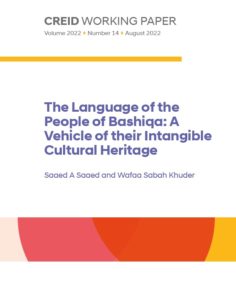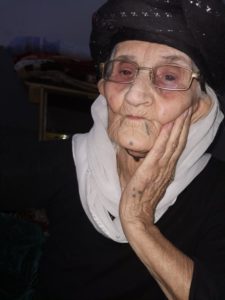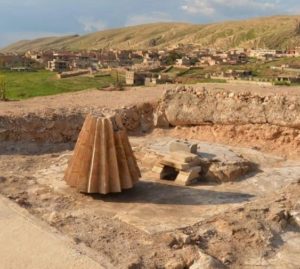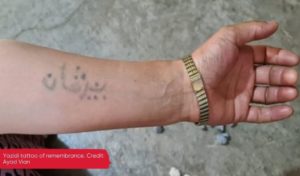With Ramadan starting this week for the world’s 1.8 billion Muslims, another much smaller and more ancient religious group largely based in Iraq is also celebrating an important religious festival. “Red Wednesday” is the Yazidi New Year, and we have been working with heritage gatherers in Iraq to record and document their culture as part of a wider effort to rebuild communities following years of devastating conflict and genocide.
The Yazidis are one of Iraq’s religious minorities, primarily living in the Sinjar and Shaykhan districts of Ninewa governorate in northern Iraq. Sadly, they are perhaps the most known religious minority in Iraq following the Daesh genocide campaign against them that started in August 2014 and resulted in the displacement of approximately 500,000 Yazidis (PDF). Almost seven years later, most still live in camps in the Kurdistan region of Iraq. During the period of the genocide, Yazidi men were killed while women and children were sexually enslaved including human rights activist and Nobel Peace Prize winner, Nadia Murad who lost her family and suffered sexual slavery.
The Yazidis were targeted mainly because they do not follow an Abrahamic religion and due to their veneration of a fallen angel – who is later redeemed – they have been portrayed devil worshippers, making them an easy target to religious extremists including Daesh.
The IDS-led CREID programme is working with young people religious from minority communities, including Yazidis, to document their heritage not as an academic exercise of anthropological interest but an essential part of helping a community to rebuild itself and survive. We are currently working with professors from the University of Dohuk who supervise young heritage gatherers from the minority groups, providing life and employment skills for the young people and supporting them preserve their local heritage and rebuild their society.
In the piece below, Dr Wafaa Khuder, a lecturer in Economics at the University of Dohuk, describes New Year (Sir Sal), which is one of the most important religious and social holidays in the Yazidi calendar.
What is Red Wednesday? “The coming of goodness and blessings”
Sir Sal, a Kurdish word comprised of two syllables – Sir (new) and Sal (year) – falls annually on the first Wednesday of April in the Eastern calendar.
The Yazidis start their new year on Wednesday as, according to their belief, the creator created the universe in six days, and on the seventh day, Wednesday (a holy day throughout the year), the earth took form at Lalish, which makes a particularly sacred religious site for the Yazidis. The remains of Sheikh Adi – a divine figure within the religion – are held within the main temple, which is believed to date back 4,000 years, and as a result, it is key place of worship for Yazidis. It is also a UNESCO World Heritage Centre.
For Yazidis, the day starts at sunset and ends at sunset on the following day which means Sir Sal celebrations therefore begin at sunset on Tuesday, running until sunset on Wednesday.
Religious ceremonies take place in Lalish and across all Yazidi villages and cities. On Tuesday evening, the Baba Sheikh (the Yazidi supreme spiritual leader) attends the sacred Lalish temple with a senior cleric, the Beshamam, and other clergy. At sunset, a fuse made out of 365 wicks representing each day of the year is lit. The temple of Lalish at this time looks like an eternal fire. In the Yazidi villages, residents gather on Wednesday to perform religious ceremonies and eat lunch together, with each family bringing a plate of food to share.
The significance of eggs and the colour red
Some traditions include bringing eggs, which represent the divine power from which the earth was created. The eggs are hard-boiled and this process represents the formation of the earth and its core in Lalish.
The eggshells are then broken, representing the explosion of the divine power and the demise of the ice crust that covered it. This symbolises durable force and eternal life on earth. Yazidi farmers then visit their crops and spread the eggshells as fertiliser, both to increase production and as a blessing.
Red anemone roses and eggshells are hung over the main entrance of Yazidi households to signify the good news of the coming of goodness and blessings and to welcome visitors. For Yazidis, the red colour of the anemone rose symbolises love and continuity in life. The roses are hung in three places close together to indicate the three months of spring.
The eggs are also often coloured in red, green, yellow and white using natural pigments. Traditionally, red onion peels are boiled and used to colour the eggs red. Lentils are used for a yellow colouring, and the local Tahliji plant is boiled and used to colour eggs in green. More recently, artificial food colouring has been used.
Children and young Yazidis also play with eggs by hitting their eggs together. Whoever gets their egg broken first loses and gives it to the winner. Children also visit other houses and are given sweets and coloured eggs as a sign of the new year’s celebration.
Villagers visit each other to share new year’s greetings, distributing a special bread covered with oil and sesame, called Sah Wak, to neighbours, friends and family members as a sign of love and peace.
On the Tuesday afternoon ahead of the Sir Sal celebrations, women usually visit the cemetery, placing eggs and bread on graves and giving some extra to the poor so that they too can remember their dead. Women also visit the graves of their ancestors, mostly on temple grounds, on the Wednesday morning, placing one spoon of bulgur on each grave while a flute player plays music.
As the Sir Sal celebrations draw to an end, Tawafat, a socioreligious carnival, begins, lasting two days until the first Friday of Eastern April, with the Tawafa ceremony held on the last day of the celebrations. Tawafat carnival involves dancing, celebrations and visiting the graves of local religious dignitaries. It is the plural of Twafa in Arabic, which means going around a place, while in Kurdish it means visitors.
Due to the significance to the Yazidis of the Sir Sal and Tawafa celebrations in April, wedding celebrations, house constructions and maintenance are all halted as everyone is expected to take part. Yazidis today are still committed to this rule and no other celebrations or events are scheduled in April that might distract them from the new year’s celebrations. For Yazidis, Sir Sal is a joyful occasion and considered the best day for faith and worship activities.
With thanks to Sama Al-Juboori and Sofya Shahab for additional contributions to this piece.




